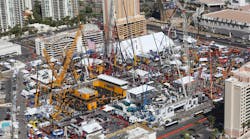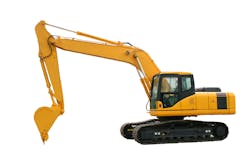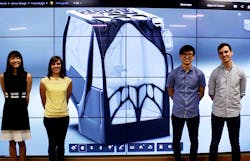The tri-annual International Fluid Power Expo (IFPE) will once again become the center of attention in the worlds of fluid power, motion control, and power transmission, showcasing a vast range of equipment, products, and services. But perhaps the most exciting demonstration at the show, which will take place in Las Vegas this coming spring (March 7-11, 2017), will be the 3D-printed excavator.
The additive manufacturing excavator (AME) will serve to demonstrate new-found capabilities of 3D printing in manufacturing for heavy-duty hydraulic machinery and construction equipment. Features of the AME include a 3D-printed boom, cab, and heat exchanger for working hydraulic fluids. The excavator will be operated at the new Tech Experience, a 75,000 square foot immersive, future-forward showcase that is part of the co-located IFPE & CONEXPO-CON/AGG.
Construction-machinery companies are already investing in additive manufacturing as a way to quickly supply excavator replacement parts that are no longer made by the manufacturer. The AME project requires teams to redesign the parts of an existing excavator, not only to improve its overall efficiency, but to streamline a quick and repeatable manufacturing strategy that produces drop-in parts as they reach the end of their useful life.
The 3D-printed excavator cab was designed by a winning team of senior students from the University of Illinois at Urbana–Champaign (UIUC) in a nationwide student contest. It was printed at Oak Ridge National Labs (ORNL) in October on a large printing bed, and is made out of carbon-fiber plastic. The boom and heat exchanger are currently being designed based on the capabilities of ORNL’s large and small 3D metal printers.
The boom will serve to demonstrate the capabilities of 3D printing for steel manufacturing. The boom, which will be printed in a single print job, will contain hydraulic lines in its body. Because it is made out of steel, the boom will also serve as a heat sink for the hydraulic fluid before it reaches the heat exchanger, improving the excavator’s overall efficiency.
The heat exchanger is being redesigned by a team from the University of Minnesota, led by Dr. Jane Davidson and Dr. Susan Mantell. Davidson brings her experience in heat exchange and systems to the group, and Mantell specializes in manufacturing and material use in composite designs. Grad student Kunal Garde and staff research scientist Dr. Brandon Hathaway are also members of the University of Minnesota heat-exchanger team. The heat exchanger will be printed by selective laser melting from an aluminum alloy that can withstand heat conditions during operation.
The heat exchanger cools the working hydraulic fluid using ambient air. The working hydraulic fluid could reach temperatures as high as 100°C before entering the exchanger, and exits at a temperature that is safe for it to reenter the system and power the hydraulic circuit. It is designed to have 15-kW cooling capacity at worse-case conditions, and measures approximately 430 mm wide by 530 mm tall by 50 mm deep.
Since the project requirements are to redesign the parts of an existing excavator, specifications like the size, shape, and position of the heat exchanger must be preserved. “If we were completely redesigning the excavator,” says Davidson, “we would consider additional innovations such as contouring the overall shape of the heat exchanger and integrating the entire cooling system. But these are ideas for the next generation of AME equipment. For now, we are creating a heat exchanger that could be used as a drop-in in almost any excavator or oil-cooling system. The design is modular and can be easily scaled for other applications.”
The team’s focus is on optimizing the heat exchanger for manufacture using 3D printing, improving heat transfer, and reducing pressure drop. 3D printing enables them to print geometries that are not enabled by traditional metal manufacturing.
In the 3D-printed design, the oil flows through many small aerodynamically shaped channels. The inside of the channels is printed with a twisted ribbon or strip fins to enhance heat transfer to the oil. The outside of the channels have a customized flow profile that minimizes the pressure drop on the air side. The unique almond-shaped cross-section channels have been shown through analysis to reduce the air-pressure gradient. Oil flows through small passages that measure a mere 8 mm in diameter, and exterior fins and interior features can be printed with a resolution as small as 0.4 mm.
The team will test the performance of their 3D-printed heat exchanger in collaboration with Austin Falkingham, the chief engineer of Adams Thermal Systems. The AME heat exchanger will undergo the same tests as a traditional heat exchanger prior to installation in the working AME excavator.
Interested in attending IFPE to see the AME in action, as well as take part in educational sessions and meet exhibitors? Register at www.ifpe.com/visit/register.





